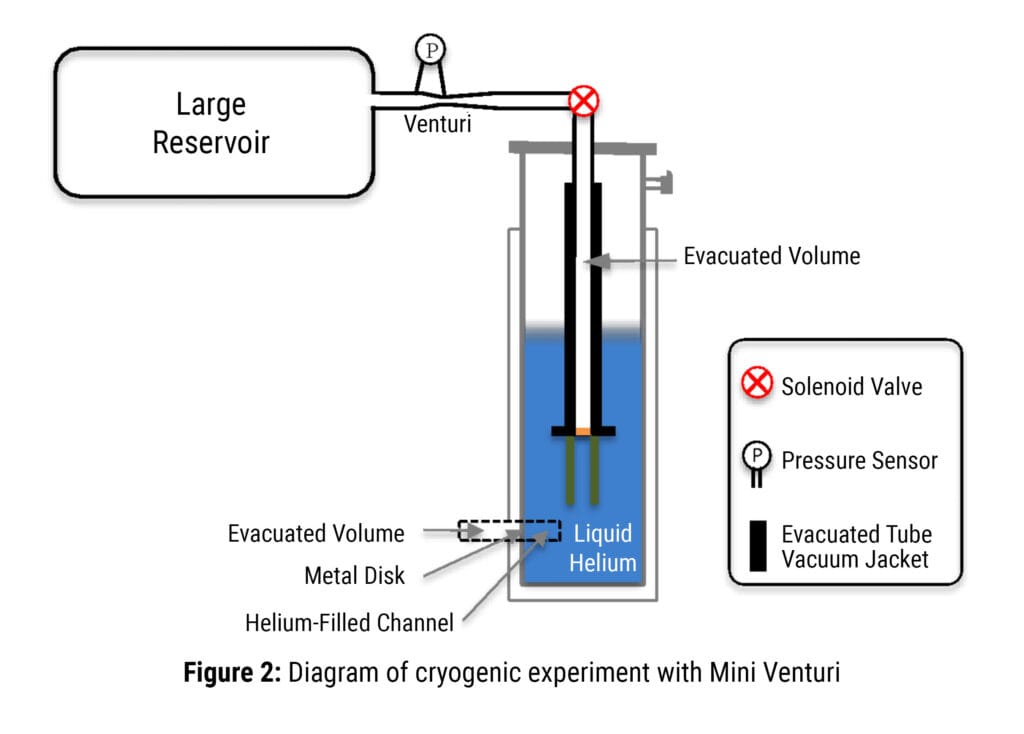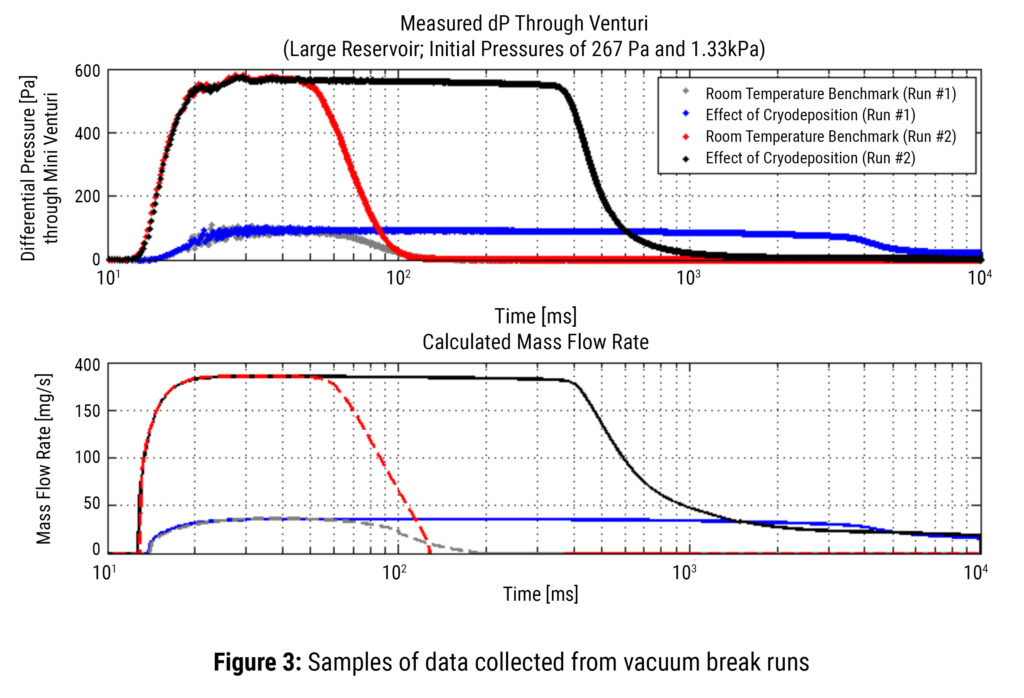The Benefits of a Mini Venturi in Cryogenics
By Bruce Briggs, President, Primary Flow Signal, Inc. & Ernesto Bosque, Doctoral Candidate at the National High Magnetic Field Lab
In academic research, accurate data and repeatable results are paramount for meaningful and valid conclusions. Within the National High Magnetic Field Laboratory, ongoing research in the Cryogenics Lab includes a study into the transient heat transfer consequent to a sudden rupture of the insulating vacuum jacket around a cryogenic system. This work is part of a larger effort in the cryogenic industry to characterize the mass transport and heat transport that transpire as ambient gas floods into a broken vacuum and condenses/freezes onto cryogenically cooled surfaces. The magnitude and rate of heat transferred could lead to significant damage to cryogenic systems or even large industrial accidents.
Experiment Specifications
In order to conduct this experiment, conditions were simulated to facilitate the most important factors to be measured: the gas mass flow rates and the consequent transient heat transfer. Some cryogenic devices are operated at extremely low temperatures (<4.2 K or -452 °F) and are contained within a vessel surrounded by an annular vacuum jacket. This vacuum jacket provides critical thermal insulation from environmental temperatures (293 K or 68 °F).
To simulate a vacuum failure, a test system was built using a series of two control volumes separated by a fast-acting solenoid valve. A reservoir tank was used to hold nitrogen gas at room temperature at a precisely controllable pressure. The second control volume modeled the insulating vacuum jacket and was initially evacuated to a very high level of vacuum (<0.1 Pa or 10-7 atm) with one of its walls in direct contact with the liquid helium, at 1.8 K. Opening the solenoid valve simulated a catastrophic rupture to a cryogenic system’s vacuum jacket – a vacuum break. Gas would then rapidly flow from the reservoir into the evacuated volume, and upon contact with the cryogenically cooled wall, the gas would immediately freeze onto the cooled surface, or cryodeposit. The cryodeposition process then continued to draw gas from the reservoir while simultaneously transferring heat to the liquid helium coolant.
Preliminary Results of the Experiment
In preliminary iterations of the experiment, a small reservoir was used, and a mass flow rate was easily deduced from a pressure vs. time trace of the reservoir. However, because the pressure in the reservoir fell, it no longer simulated a vacuum break to the environment, whose pressure remains constant. The small reservoir was thus replaced with a much larger one, more closely reflecting real-world conditions. In so doing however, the smaller pressure change in the reservoir was no longer sufficient to precisely measure the mass flow rate. An orifice meter was then placed downstream of the reservoir to directly measure the mass flow rate of the gas moving from reservoir to broken vacuum.

In Figure 1, the solid black trace illustrates how quickly the pressure in the small reservoir fell as gas flowed from the reservoir into the broken evacuated volume. The orifice flow meter (the dotted red trace) is shown to have changed flow dynamics at levels that could not be tolerated for this experiment. Upon further analysis, it was found that the throat of the orifice plate was limiting the mass flow rate, and the total pressure and temperature variations from the gas compression, just before the orifice, and expansion, downstream of the orifice, increased the error in the calculated mass flow rates.
What was needed was a flow meter with high precision, low energy loss, and accuracy even at a small line size. Before finding the Mini Venturi, other devices were considered. However, the flow rate profile of the experiment starts at zero flow, rapidly rises up to choked flow, and ultimately experiences an exponential decay. Thermal mass flow meters are unreliable when starting from zero flow, and pitot tubes obstruct flow when dealing with small line sizes. One of the best, if not the best device that fit these requirements was a Mini Venturi meter designed and built by Primary Flow Signal.
Using a Mini Venturi in the Research
After contacting Primary Flow Signal and discussing the nature of the research, the company donated the Mini Venturi. It replaced the orifice meter and immediately proved less obtrusive to the flow, as illustrated with the blue dashed trace in Figure 1. The reduction in adverse effects on the flow dynamics is due to the profile of the Mini Venturi, resulting in small headloss and preserving the ability to accurately measure the differential pressure between inlet and throat. Effectively, the discharge coefficient of the Mini Venturi in this experiment was much closer to the ideal than the orifice plate could achieve, particularly in a laboratory setup with limited upstream and downstream piping.

Shown in Figure 2, the final test system consisted of a solenoid valve separating the reservoir tank and the evacuated volume, with one wall of the evacuated volume in contact with the liquid helium coolant. As the experiment requires the presence of liquid helium, the cryogenic vessel holding the liquid helium and its respective insulating vacuum jacket are outlined in gray. The dotted box on the lower left illustrates the physical meaning of what was simulated by the experimental design. Finally, a series of thermometers were inserted into the system to measure the development of thermal gradients consequent to the vacuum break.
The thermometers in the test system provided measure of temperature changes in the evacuated volume wall and neighboring liquid helium, from which heat fluxes were calculated. To ensure that the results made physical sense, they needed to be balanced with the amount of heat energy brought in by the nitrogen gas. This was possible by measuring how much gas (mass) moved from the reservoir to the evacuated volume.
The Mini Venturi measured the mass flow rate, which was then correlated directly to how much heat had been dumped into the system. In effect, the mass flow rate is proportional to the total heat transfer rate. Both heat transport and mass transport measures were compared and found to closely match, characterizing the observed heat and mass transfer while ensuring the results remained self-consistent.
The practical application of this experiment revolves around the cryodeposition process and its effect on cryogenic system during vacuum failures. This experiment brings forward measurement of heat fluxes and flow rates that have not been documented previously. Data captured from this experiment will be provided to further academic study at research facilities throughout the world. A sample of the data collected is illustrated in Figure 3 and is discussed in greater detail in a dissertation pending publication.

The Mini Venturi remains at the National High Magnetic Field Lab and is currently being used by other doctoral candidates to continue this line of research.
Learn more about Primary Flow Signal’s work in cryogenics, or reach out to a flow measurement expert to see what solutions PFS can provide you.
Author Bios
Bruce Briggs is the President, and Principal of Primary Flow Signal, Inc., a global manufacturing, engineering, and technology resource focusing on highly accurate, repeatable and reliable differential flow meters.
Ernesto Bosque is a doctoral candidate and graduate research assistant at the National High Magnetic Field Lab, which is jointly operated by Florida State University, Los Alamos National Laboratory, and the University of Florida in Gainesville.
